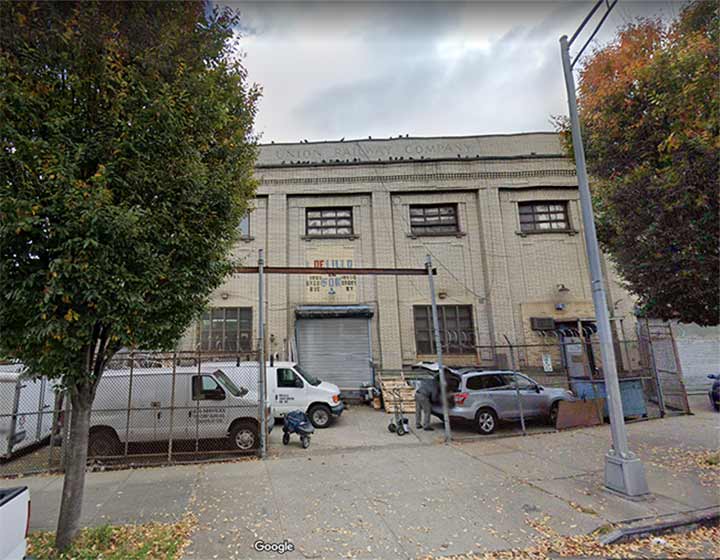
If you look a street map of the southern Bronx, Brook Avenue seems to act oddly, running in a straight line north out of Mott Haven, but then curving northwest and then northeast in Morrisania, forming a complicated intersection at Gillespie Square with Webster, Melorose and Park Avenues at the Metro North RR cut. That’s because when it was laid out in 1876 it overlays Mill Brook, which once ran on the surface but is now underground. If you look at this outline map of the Bronx in 1874, Brook Avenue nearly exactly follows the Mill Brook that appears on the map.
Today, I’m concerned with a yellow brick building on the east side of Brook Avenue just north of Gillespie Square with the words “Union Railway Company” on the roofline. Today it seems to be a warehouse connected with hardware wholesaler DeLillo and Sons. But what was the Union Railway Company?
This would appear to be a car barn or repair shop associated with the trolley line run by Union Railway, formed in 1892 by the merger of the Harlem Bridge, Morrisania and Fordham Railway with the North Third Avenue and Fleetwood Park Railway and the Melrose and West Morrisania Railroads.Like the many railroads in Queens that gradually merged and folded into the Long Island Rail Road, son there were many different railcar lines in the Bronx that started out as horsecars in the mid-19th Century. Union Railway itself later merged with the Third Avenue Railway, which wound up operating most of the trolley lines in Manhattan and the Bronx. The Third Avenue ran the two boroughs’ (as well as the Steinway Lines in Queens from 1922-1938) until all streetcars in Manhattan and Bronx were converted to diesel buses in 1948.
As always, “comment…as you see fit.” I earn a small payment when you click on any ad on the site.
Thanks FNY correspondent Gary Fonville.
11/29/21


2 comments
Third Avenue Railway ended up controlling the entire Bronx trolley network after the early 20th century. It only controlled six Manhattan-only routes, but one stretched the length of the island and included tracks on its namesake avenue. The Bronx trolley routes included many that crossed the Harlem River into Upper Manhattan, at 125th St. and above. Third Avenue also controlled most of the trolley routes in Westchester County, including Yonkers, Mount Vernon, New Rochelle, White Plains, and various neighboring communities.
In the 1920s Third Avenue created a new group of Bronx bus routes to handle that borough’s large population increases after 1920. In 1940 New York City, in the person of Mayor LaGuardia, mandated that Third Avenue convert its entire system to bus by 1960. Third Avenue began conversion in Manhattan and The Bronx in 1941, but was immediately interrupted due to World War II. Conversion was completed 1946- 1948. A subsidiary firm known as Surface Transportation Corporation was established to run the bus routes and that name was eventually adapted for the entire system. In 1956 Surface Transportation was purchased by the Fifth Avenue Coach Lines, which controlled most of Manhattan’s buses.
The entire Fifth Avenue/Surface Transportation network in The Bronx and Manhattan disappeared suddenly in 1962, after its management provoked its workers, represented by the Transport Workers Union, to go on strike. NYC promptly seized the property, and ever since an agency called Manhattan and Bronx Surface Transit Operating Authority, or MABSTOA, has operated its routes. MABSTOA is, of course, part of the larger MTA.
This material is adapted from my own book, From a Nickel to a Token, Chapters 4 and 16.
i rember when i livedm on west 69th street in manhattan and surfae trasit busesm came down 69tjh st towards 11th avenue (at this point know as west end avenue) they had come down from amsterdam avenue which at 59tjhst ? going spoiuth was 10th avenue. as far as i klnow 10tjh 11th amsterdam and west end still have same designations. alot has changed inn that particilar area due to lincoln center campus and trump bldgs along west end and the hudson. after all these hyears and reading etc on buses transit etc now know where these buses cam from and wnet (i was young). living on wwest side in 2 locations as yoing person bascically rode omnibus or trains. even when had to move jpper westside 100sts area.